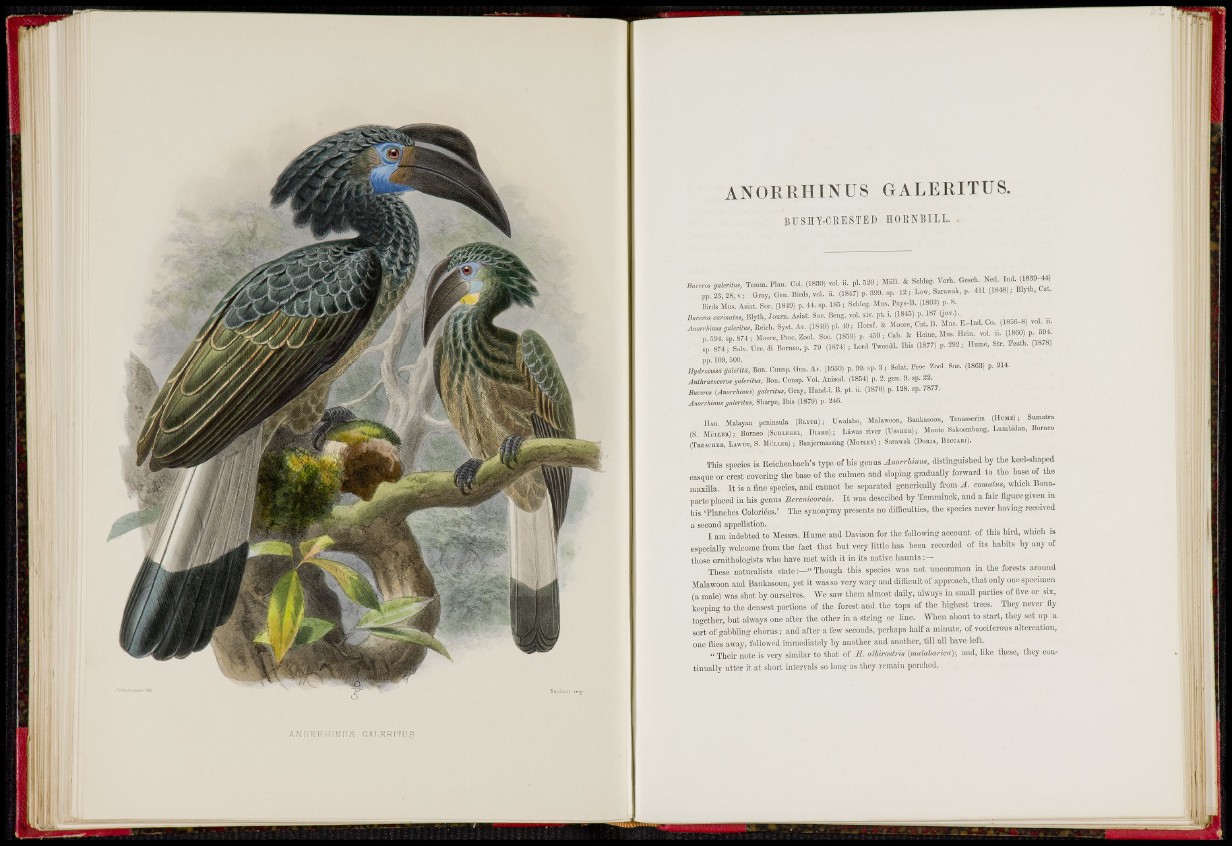
A N O R E H I N U S GAIERITÜS
ANORRHINUS GALERITUS.
ß ü S H Y - C E E S T E D IIOKNBILL. .
pp. 23, 28, v; G»,, Gm. Bird., vol. ii. (IM?) p. 399. sp. 12, Low, S™v. , l , p. I l l (1818), Blylt, CI.
Bird, Mu.'. A.mt. Soo. (1849) p. 4-1. .p. 185; SoMog. Mm. P.J>-B. (1862) p. 8.
i j ™ . Blytl., Jonrn. A.i.t. Soo. Bong. vol. xiv. pi. i. (1845) p. 187 (jm.).
Boich. 8 ,«. ÄV. (18.») pi. 49, I t a f . & Moo,,, C . B . M.., E.Jnd. Co. ( 1 ^ 8 ) vol ...
p. 594. .p. 874, Moo„, P,oo. Zool. Soo, (1859) p. 450, Cb. Iloino, Mm. Horn. vol. ... (1860 p o94
,p. 871, S.lv. ÜO0. di Bornoo, p. 79 (1871) , Lord Twoodd. Ibi. (1877) p. 292, Humo, Str. Po.tt. (1878)
pp. 109, 500,
a j i r o c m u ¡Ar iU, Bo... Comp. Go... Av. (1850) p. 90. 3 , SoW. Roo, Zool. Soo. (1863) p. 214.
ArUhmcera „alerilm, Bon. Co..sp. Vol. Am.od. (1S5.1) p. 2. go». 9. sp. 22.
Buco- [AnmMnu,) ,alerilu,, Gi.y, H.odJ. B. pt. ii. (1870) p. 128. .p, 7877.
AnorrMmis galeyiiui, ,Sl.arpe, Ibis (1879) p. 3.16.
11». M.1.V..1 po»in.»l> (BmH) , Uw.l.lio, MdawooB, B.nki«oon, Ten.«orim (Hu»«), Sum.tr.
(S. Miiio..), Bo™o (Scno,o,i, D,„p), Uwm rive, (U,B..„) , Monte S.lo.mb.ng, L..mbidan, Bornoo
(TREACHER, LAWUT, S. ML-nnnR) , Banjermaasing (MOTLEY) , Sarawak (DOR.A, BEOCAR.).
Tl™ species is Ecichentooh' s type ot Ms genus Amrrhmu,, distingaislied b , the keel-sl.aped
casque or crest covering the Ijase of Hie culmen and sloping gradually forward to the tas6 ot the
n i a i ü l a . It is a fine species, and cannot be separated generioally from A. cmuatm, which Bonap
a r t e placed in his genus Berenicm-nü. It was described by Temminck, and a fair figure given in
his 'Pianelies Colonies.' Tile synonymy presents no difficulties, the species never haviag received
a second appellation.
I am indebted to Messrs. H ume and Davison for the following aeconnt of this bird, wlneh is
especially welcome from the fact that but very little lias boon recorded of its habits by any of
those ornithologists who have met with it i n its native haunts : —
These naturaUsts state:—" Though this species was not uncommon in the forests around
l l a l a w o o n and liankasoon, yet it was so very war y and difiicult of approach, tha t onl y one specimen
(a male) was shot by ontselves. Wc saw them almost daily, always in small parties of five or six,
keeping to the densest portions of the forest and the tops of tile highest trees. They never fly
together, but always one after the other in a string or line. When about to start, they set up a
sort of gabbling ehorns; and after a few seconds, perhaps half " " i " " ' « . vociferous altercation,
one flies away, followed immediately by another and another, till all have left.
" Thei r note is very similar to that ot II. alUrostria (moioSdTOo); and, like these, they cont
i n u a l l y utter it at short intervals so long as they remain perebcd.
B